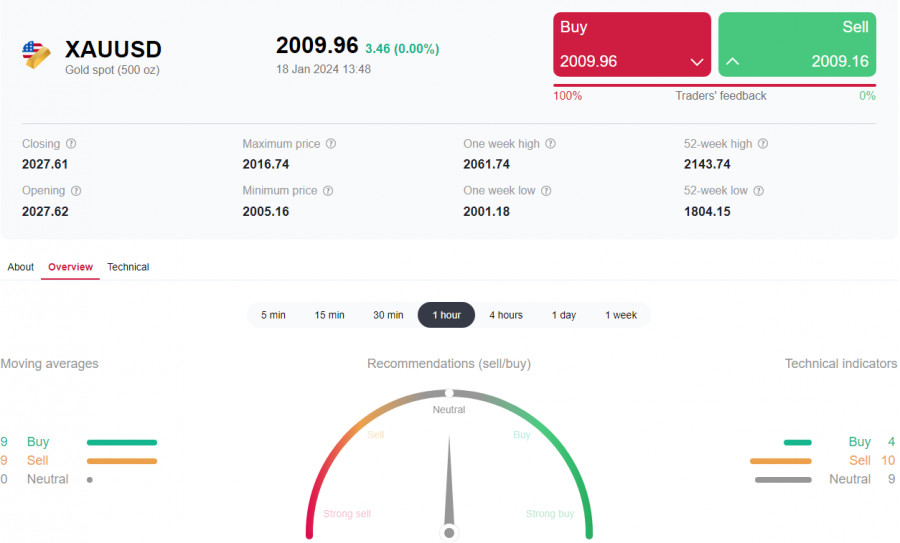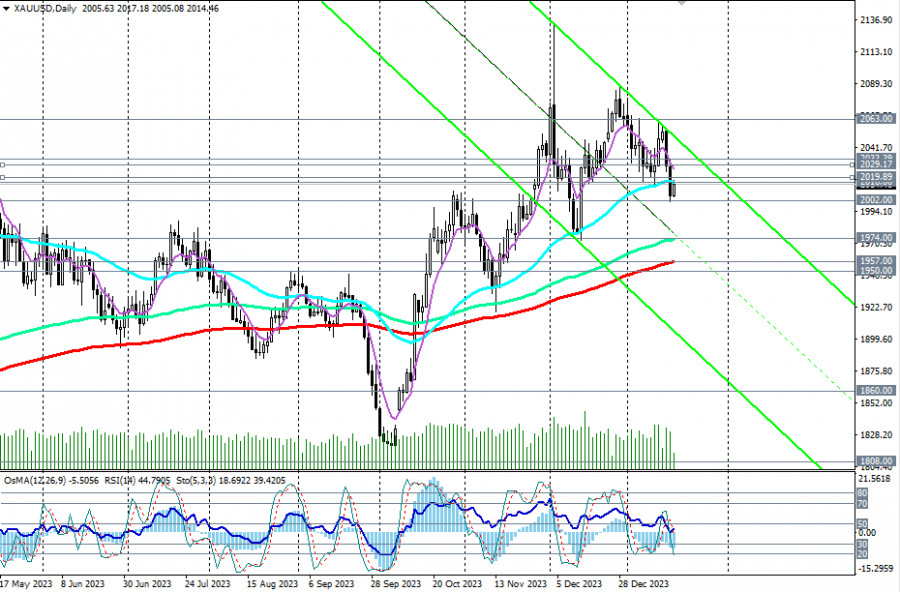Having reached a local 5-week low near the 2002.00 mark on Wednesday, the XAU/USD pair resumed its growth on Thursday. As of writing and at the beginning of the American trading session, it was trading near the 2015.00 mark, attempting to break above the important resistance level of 2016.00 and resume the upward trend.

The main credit here, undoubtedly, goes to the dollar, which has managed to strengthen significantly since the beginning of this month. Its DXY index added about 3% during this time, reaching a peak since December 14th and a mark of 103.45 last Wednesday.
In recent days, the strengthening of the dollar has been facilitated by a sharp increase in geopolitical tensions in the Red Sea region and the Middle East and a weakening of expectations regarding the Federal Reserve's imminent easing of monetary policy. Members of the Federal Reserve's leadership have increasingly stated that the market's expectations about the imminent start of the Fed's monetary policy easing are too high. For instance, Federal Reserve Board member Christopher Waller noted on Wednesday that he considers it premature to adjust borrowing costs, as it is now better to ensure that the trend of decreasing inflationary pressure is sustainable.
Moreover, data published last week showed that the Consumer Price Index in December accelerated to +0.3% and to +3.4% annually after growing by +0.1% and +3.1%, respectively, in the previous month. Although the annual core CPI decreased in December from +4.0% to +3.9%, these data exceeded economists' forecasts, giving the dollar a bullish impulse. Its DXY index jumped after the CPI publication to a 4-day high and a mark of 102.51. Before this publication, many market participants had priced in the first Federal Reserve rate cut as early as March. However, the acceleration of inflation in the USA significantly reduced this probability, pushing the timeline to the second half of the year.
The dollar is also receiving support from moderately positive macro statistics from the USA. According to data presented on Wednesday, the volume of retail sales grew in December from +0.3% to +0.6% (with a forecast of +0.4%), the "retail control group" indicator - from +0.5% to +0.8%, and volumes of industrial production grew in December by +0.1% after a zero dynamic in November.
Meanwhile, there is still high demand for gold on commodity exchanges. According to the Chicago Mercantile Exchange, the average daily trading volume for gold reaches 436,000 positions, while from December 27th to January 4th, it was 247,000.

As per the final report for 2023 published on Wednesday by the World Gold Council, the rise in gold quotes was most influenced by demand from central banks and increased geopolitical risks. The ongoing tension in the Middle East may soon again affect the redistribution of interest in safe-haven assets in favor of gold, economists believe, especially since this year, the world's major central banks are likely to ease their policies and lower interest rates.
Therefore, the XAU/USD pair is likely to continue its upward trend.
On Friday, market participants will focus on the preliminary Consumer Sentiment Index from the University of Michigan, which is expected to rise from 69.7 to 70.0 in January. If the data turns out to be positive, it could give the dollar a new bullish impulse at the end of the week.

From a technical standpoint, despite the decline observed on Wednesday, XAU/USD maintains an upward dynamic, trading in the zone of medium-term and long-term bullish markets. However, for a more successful recovery, the price still needs to first overcome the marks of 2016.00, 2020.00.
The material has been provided by InstaForex Company - www.instaforex.comfrom Forex analysis review https://ift.tt/bxNMQuy
via IFTTT
